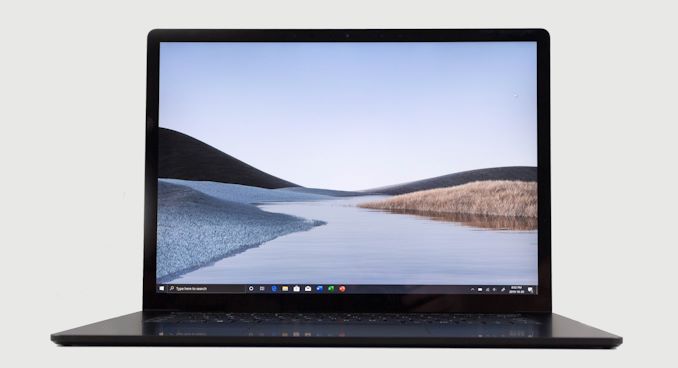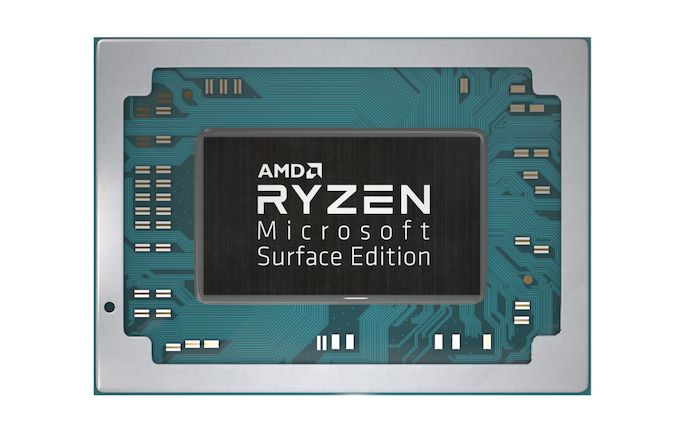The Microsoft Surface Laptop 3 Showdown: AMD's Ryzen Picasso vs. Intel's Ice Lake
by Brett Howse & Andrei Frumusanu on December 13, 2019 8:30 AM ESTFinal Words
Two laptops. Two platforms. It is rare to have a chance to see a manufacturer offer such equal footing to both AMD and Intel by outfitting a premium laptop with processors from both. It represents a rare opportunity to get to test the latest processors from AMD and Intel in a laptop in such an apples-to-apples fashion.
In the laptop space, design, cooling, and a manufacturers requirements can play a big part in how a particular chip performs, thanks to adjustable power level settings, surface temperature adjustments, and more. We have seen the lowest tier CPU outperform the highest tier CPU just by the virtue of a better cooling system, so to have processors from AMD and Intel, both of which launched in 2019, in the same chassis is a wonderful opportunity.
There aren’t too many ways to sugar coat the results of this showdown though. AMD’s Picasso platform, featuring its Zen+ cores and coupled with a Vega iGPU, has been a tremendous improvement for AMD. But Intel’s Ice Lake platform runs circles around it. Sunny Cove cores coupled with the larger Gen 11 graphics have proven to be too much to handle.
On the CPU side, no one should be too surprised by the results. We've already seen on the desktop that AMD’s Zen+ cores were competitive, but slightly slower than the previous Skylake platform; and the new Sunny Cove microarchitecture from Intel is a big step forward in terms of IPC for Intel. On purely CPU based tasks, Ice Lake really stretched its legs, and despite this being a 3.9 GHz chip, in single-threaded SPEC 2017, it managed to come very close to a 5.0 GHz Core i9-9900K with a massively higher TDP. Zen+ is outclassed here, and that showed in the benchmark results, and especially in the benchmark time. On our 8-thread SPEC 2017 run, the Ice Lake platform finished just a hair over two hours ahead of Picasso.
But things fare better for AMD on the GPU side of matters. Even though Intel has certainly closed the gap with Ice Lake's iGPU, AMD seems to continue to hold an advantage, especially on the 11 Compute Unit Ryzen Surface Edition processor found in the Surface Laptop 3. Intel has dedicated a lot more die area to the GPU and the results put them almost on equal footing with the Vega based GPU on Picasso. On the more complex GPU tasks, AMD tends to have a slight lead, and AMD’s low-level driver support also seems to benefit them on DirectX 12 based tasks. But, Ice Lake’s GPU is helped by the much quicker CPU it is coupled to, so depending on the specific test it can be even quicker.
Ice Lake does all of this with much better power efficiency as well. Overall battery life is quite a bit longer, and idle power draw is notably lower as well. Case in point: at minimum screen brightness, the Ice Lake system was pretty much only sipping power, drawing around 1.7 Watts, versus the 3.0 Watts for the AMD system.
It was fantastic to see AMD get a design win in a premium laptop this year, and the Surface Laptop 3 is going to turn a lot of heads over the next year. AMD has long needed a top-tier partner to really help its mobile efforts shine, and they now have that strong partner in Microsoft, with the two of them in a great place to make things even better for future designs. Overall AMD has made tremendous gains in their laptop chips with the Ryzen launch, but the company has been focusing more on the desktop and server space, especially with the Zen 2 launch earlier this year. For AMD, the move to Zen 2 in the laptop space can’t come soon enough, and will hopefully bring much closer power parity to Intel’s offerings as well.
Meanwhile for Intel, Ice Lake has been years in the making, and, after a long delay, it is finally here. After digging into the platform in-depth, it’s clear that Ice Lake is an incredibly strong offering from Intel. The CPU performance gains are significant, particularly because they were made in the face of a CPU frequency deficit. But the biggest gains were on the GPU side, where Intel’s Gen 11 GT2 in its full 64 Execution Unit configuration is likely the biggest single increase in GPU performance since they started integrating GPUs. It pulls very close to AMD’s Vega, closing the gap in performance to almost zero.
2019 has been a big year in the laptop space, with both Intel and AMD bringing new tools to the game. 2020 should be just as exciting, and if we’re lucky, we’ll get another chance to do this all over again.













174 Comments
View All Comments
Andrei Frumusanu - Friday, December 13, 2019 - link
Correct. Between 3-5 hours each ST and MT.Fataliity - Friday, December 13, 2019 - link
"despite this being a 3.9 GHz chip, in single-threaded SPEC 2017, it managed to come very close to a 5.0 GHz Core i9-9900K with a massively higher TDP"This statement is contradictory. "Single-Threaded" Spec, then "Massively higher tdp" 9900k is 8 cores. which reflects the TDP. Single-Thread is one core, which is completely different. If you scale up the frequency / wattage graph, a Ice Lake 3.5GHz at 8 cores would be about 100 watts. Which im pretty sure is really close to a 9900k off the top of my head. Except this is at 3.5 and 9900k is hitting 5GHz.
tipoo - Friday, December 13, 2019 - link
Shame AMD didn't have 7nm Zen 2 for mobile ready in time for this. Maybe that's when the partnership will make more sense, until then I wish the consumer 15" was also Ice Lake.s.yu - Friday, December 13, 2019 - link
The difference is too great. This is almost an i3 to i7 comparison, while the price difference is confusingly little. Though the Intel version could be hard to acquire, whoever's interested in this model should aim for the Intel version, even through unofficial channels.eastcoast_pete - Friday, December 13, 2019 - link
Interesting! Guess Chipzilla is (still) king of the hill in mobile; quite impressive, as this IL i7 even comes close to desktop i7 speeds. AMD really needs to get 7 nm Zen2 or Zen2+ into mobile APUs pronto - they're leaving a lot of money on the table. Now is the time, before chipzilla gets their manufacturing problems worked out!MBarton - Monday, December 30, 2019 - link
Less impressive when you consider the amount of money and number of defective CPU's required by Intel fabs to get to this point. When you factor in how much money Intel has dumped into their 10nm process over the last decade the money they're making off of 10 nm is sad.Consumer1 - Friday, December 13, 2019 - link
Interesting to me is the slow speed of the memory with the Ryzen. Ryzen does better with faster memory. To bad we can't equalize the memory to see the effect.Dustin Sklavos - Friday, December 13, 2019 - link
I would never in a million years accuse AnandTech writers of being shills.That said, you guys didn't notice the Ice Lake CPU was being allowed to peak and sustain a solid 8W higher than the Ryzen CPU was?
Yes, even with the higher ceiling on Ice Lake, it's able to bring its idle draw down way lower than Ryzen's, so the bursty nature of garden variety on-battery web surfing is going to heavily favor Ice Lake.
But plugged in, full bore benchmarks, the Ice Lake unit is at a clear advantage for power budget and that's concerning. It's not really as fair a fight when the Ryzen is being kneecapped, and while I don't think it would change the overall results, I *do* think the CPU tests wouldn't be the bloodbath that they are, and the GPU tests (and especially gaming tests) would be a clearer cut win for AMD.
Brett Howse - Saturday, December 14, 2019 - link
I mentioned this in the text but the data logging tool is monitoring CPU core power on Ryzen and SoC package power on Core so the data isn't 100% comparable just due to what each company exposes to be monitored. If you look at the CPU temperatures on the Cinebench R20 test as an example the CPU temperatures are very similar so I don't think the power budget is as far off as you'd think, although Intel is pretty aggressive with boost.Fataliity - Saturday, December 14, 2019 - link
Zen+ APU is also a 216mm die vs Intel's 125mm die. So it has double the surface area, which should mean almost double the heat dissipation (maybe less). So Intel's numbers being twice as high in power draw actually makes sense when you consider the area that is dissipating the heat.